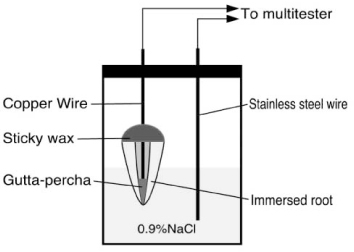J Korean Acad Conserv Dent.
2006 May;31(3):186-191. 10.5395/JKACD.2006.31.3.186.
Effect of two different calcium hydroxide paste removal techniques on apical leakage: an electrochemical study
- Affiliations
-
- 1Department of Conservative Dentistry, Samsung Medical Center, Sungkyunkwan University School of Medicine, Korea.
- 2Department of Prosthodontics, Samsung Medical Center, Sungkyunkwan University School of Medicine, Korea. kwon@smc.samsung.co.kr
- 3Department of Conservative Dentistry, College of Dentistry, Seoul National University, Korea.
- KMID: 2175818
- DOI: http://doi.org/10.5395/JKACD.2006.31.3.186
Abstract
- This study evaluated the effect of two different calcium hydroxide (Ca(OH)2) paste removal techniques on the apical leakage of canals obturated with gutta percha cones and sealer after removing a Ca(OH)2 dressing using an electrochemical method. Seventy extracted single-rooted teeth were instrumented on with Profile rotary files under NaOCl irrigation. Fifty-eight canals were filled with calcium hydroxide paste, which was then removed using one of the following two techniques. In group A, calcium hydroxide was removed using only NaOCl irrigation, and in group B, the canals were re-prepared with a Profile rotary files-one size larger than the previous instrument and were irrigated with NaOCl. In both groups, the root surfaces were coated twice with nail varnish from CEJ to an area 4 mm away from the apex after canal obturation. Apical leakage was measured using an electrochemical method for 24 days. All the specimens showed leakage that increased markedly in the first three days. There was no significant difference between the two groups (p > 0.05). The effect of two calcium hydroxide paste removal techniques on the apical leakage was not different during a short period.
MeSH Terms
Figure
Reference
-
1. Ingle JI, Beveridge E, Glick D, Weichman J. Ingle JI, Bakland LK, editors. The Washington study. Endodontics. 1994. 4th ed. 25–44.2. Bystrom A, Sundqvist G. The antibacterial action of sodium hypochlorite and EDTA in 60 cases of endodontic therapy. Int Endod J. 1985. 18:35–40.
Article3. Hasselgren G, Olsson B, Cvek M. Effects of calcium hydroxide and sodium hypochlorite in the dissolution of necrotic porcine muscle tissue. J Endod. 1988. 14:125–127.
Article4. Andersen M, Lund A, Andreasen JO, Andreasen FM. In vitro solubility of human pulp tissue in calcium hydroxide and sodium hypochlorite. Endod Dent Traumatol. 1992. 8:104–108.
Article5. Tronstad L. Root resorption - etiology, terminology and clinical manifestations. Endod Dent Traumatol. 1988. 4:241–252.
Article6. Foreman PC, Barnes F. A review of calcium Hydroxide. Int Endod J. 1990. 23:283–297.
Article7. Heithersay GS. Calcium hydroxide in the treatment of pulpless teeth with associated pathology. J Br Endod Soc. 1975. 8:74–93.
Article8. Fava LR, Saunders WP. Calcium hydroxide pastes: classification and clinical indications. Int Endod J. 1999. 32(4):257–282.
Article9. Siqueira JF Jr, Lopes HP. Mechanisms of antimicrobial activity of calcium hydroxide: a critical review. Int Endod J. 1999. 32:361–369.
Article10. Ricucci D, Langeland K. Incomplete calcium hydroxide removal from the root canal: a case report. Int Endod J. 1997. 30:418–421.
Article11. Lambrianidis T, Margelos J, Beltes P. Removal efficiency of calcium hydroxide dressing from the root canal. J Endod. 1999. 25:85–88.
Article12. Webber RT, Schwiebert KA, Cathey GM. A technique for placement o calcium hydroxide in the root canal system. J Am Dent Assoc. 1981. 103:417–421.13. Porkaew P, Retief DH, Barfield RD, Lacefield WR, Soong SJ. Effects of calcium hydroxide paste as an intracanal medicament on apical seal. J Endod. 1990. 16:369–374.
Article14. Holland R, Alexandre AC, Murata SS, Dos Santos CA, Dezan JrE. Apical leakage following root canal dressing with calcium hydroxide. Endod Dent Traumatol. 1995. 11:261–223.
Article15. Wu MK, Kontakiotis EG, Wesselink PR. Decoloration of 1% methylene blue solution in contact with dental filling materials. J Dent. 1998. 26:585–589.
Article16. Kontakiotis EG, Wu MK, Wesselink PR. Effect of calcium hydroxide dressing on seal or permanent root filling. Endod Dent Traumatol. 1997. 13:281–284.17. Jacobson SM, von Fraunhofer JA. The investigation of microleakage in root canal therapy. Oral Surg. 1976. 42:817–823.
Article18. Delivanis PD, Chapman KA. Comparison and reliability of techniques for measuring leakage and marginal penetration. Oral Surg Oral Med Oral Pathol. 1982. 53:410–416.
Article19. Pommel L, Camps J. Effects of pressure and measurement time on the fluid filtration method in endodontics. J Endod. 2001. 27:256–258.
Article20. Pommel L, Jacquot B. Lack of correlation among three methods for evaluation of apical leakage. J Endod. 2001. 27:347–350.
Article21. Schuurs AH, Wu MK, Wesselink PR, Duivenvoorden HJ. Endodontic leakage studies reconsidered. Part II. Statistical aspects. Int Endod J. 1993. 26:44–52.
Article
- Full Text Links
- Actions
-
Cited
- CITED
-
- Close
- Share
- Similar articles
-
- A Comparison of the irrigation systems in calcium hydroxide removal
- The significance of diagnosis and treatment planning in periapical lesion overfilled with calcium hydroxide paste
- Effect of calcium hydroxide application time on dentin
- Prognosis of the Apical Fragment of Root Fractures after Root Canal Treatment of Both Fragments in Immature Permanent Teeth
- Nerve Injury from Overfilled Calcium Hydroxide Root Canal Filling Paste for Maxillary Lateral Incisor Endodontic Treatment



